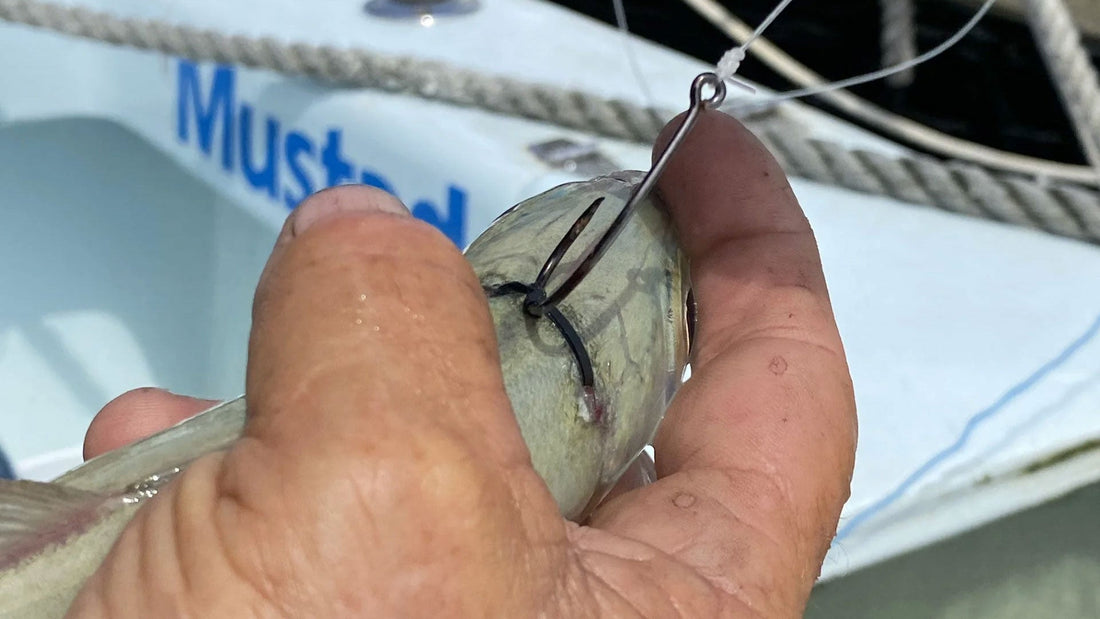
How to Bridle Live Bait
Learning how to bridle live bait is a valuable offshore fishing technique. It helps keep bait alive longer and leaves the hook free for a more secure hook-up, so anglers don’t miss an opportunity. We’ll break it down step-by-step with expert advice from Ray Rosher, an accomplished IGFA-certified captain and one of the top bait-rigging captains in the world who has racked up over 30 billfish tournament wins with bridled live baits.
Captain Rosher’s process for bridling live baits is straightforward, but like any new skill, bridle rigging takes practice. Remember to handle baits carefully when using a live bait rig to give yourself the best chance of landing a fish.

Gear for Bridling Live Bait
- Rigging needle, an open-eye needle
- Rigging bands for smaller baits or rigging floss for larger baits
- Monofilament or fluorocarbon leader
- Heavier wire, Circle hook or J hook, match hook size to bait size
- Live bait of choice
Step-By-Step: Bridling Live Bait
1. Gather bait rigging tools. Anglers will need a rigging needle, rubber bands, rigging floss or Dacron line, and a hook. The hook size will vary by the live bait you’re using and the target species.
2. Tie a short loop of Dacron line or rigging floss and attach one end to the rigging needle and the other to your hook.
3. Insert the rigging needle through the front of the bait's eye socket and pull the loop through.
4. Take the hook through both ends of the loop.
5. Twist the hook several times until the loop creates a dense knot at the attachment point.
6. Slide the point of the hook back through the base of the knot.
7. Take your bridled bait and rotate the hook 90 degrees or more to penetrate the fish's jaw.
The Development of Bridling Live Baits
The bridling live bait process has changed dramatically since anglers first started using it, and it took several trial-and-error attempts before it became effective and advantageous.
Rosher remembers the days when anglers would run a J-hook directly through their baits, an unsuccessful method. “Often the hook would come out, or the bait would slide to the hook eye and allow the point to turn in and bury itself in the baitfish.” He said.
From the J-Hook, floss became an alternative. However, when anglers wanted to pre-bridle baits, they came up short because the floss removed the bait’s protective slime coat, which is essential to its longevity and durability as a bait.
With protecting the slime coat in mind, Rosher’s team started using rubber bands with an open stainless needle. However, the rubber bands broke too quickly with sun exposure, so Rosher’s team pivoted to silicone bands. Rosher was looking for a material with a high UV resistance and a good memory to keep the hook in position against the baitfish’s body, resulting in the R&R’s proprietary rigging bands.
Regardless of which type or brand of rigging band you use, it must be the right size. Using the wrong-sized band can pinch the bait’s flesh down, allowing the bait to be knocked off. The optimal-sized band helps prevent tension build-up on the band.
Rosher’s team also discovered that stainless steel needles weren’t an ideal solution because they required a stone to soften the needle-eye edges, which would damage the soft bands. To avoid that, Rosher’s team started using synthetic needles molded with microscopic edges and a tab that tenses the band to resist it from coming off the needle. This method created a small bump at the tip of the eye to help retain the band.
After much trial and error, Rosher’s team successfully developed a bridling live bait technique that has proven successful time and time again.
Bridle Placement: Back Bridle vs. Nose Bridle
There are two main ways to bridle live baits, either through the nose or the back, depending on how you plan to fish.
Rosher uses a nose-bridle when seaweed is prevalent because it’s easier to pick up the bait on a flat or kite line and shake off the seaweed. He also likes to use nose bridles when fishing fast-moving baits like small bonito, tinker mackerel, or ballyhoo. These baits won’t move through the water quickly or naturally if they’re back bridled.
When using slower bait like herring, a back bridle is best. “When you nose-bridle herring, they lay on their sides like a pancake. Make sure to bridle deep enough in the tissue for some meat to give the band purchase.” If you’re an angler kite fishing and moving slowly, use a back bridle so the hook is forward behind the head. By doing so, the herring will swim at a normal angler because back-bridling pulls it along, head down. Watch Rosher in action as he demonstrates how to bridle rig herring.
On rare occasions, Rosher won't bridle his baits like in wahoo tournaments or meat-fishing for king mackerel. The toothy fish will likely nick the band and detach hooks. Rosher's team uses a large circle hook or J-hook through the bait in these situations. Knowing when to use a back or nose bridle is key to maximize the effectiveness of your bridled bait.

An essential part of fishing with live bait starts at the first scoop from the bait tank. The AFTCO Bait Net is perfect for scooping delicate baits like anchovies, menhaden, and sardines. It helps anglers capture the liveliest baits while protecting the inside of the tank from chips or scratches.
Whether you’re an avid angler chasing bluefin tuna or a beginner hitting the water with a fishing guide with Captain Rosher’s perfect bridling live bait process, you’ll be set for success on deck. For more saltwater fishing tips, check out our saltwater how-to collection and ensure you’re outfitted in our angler-designed and tested tackle that’s up for any challenge on the water.





